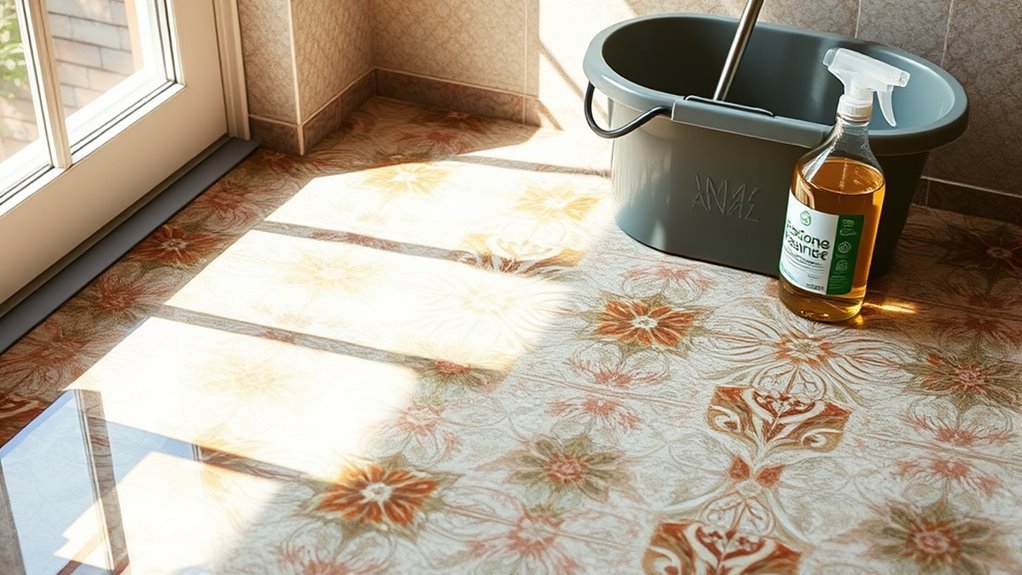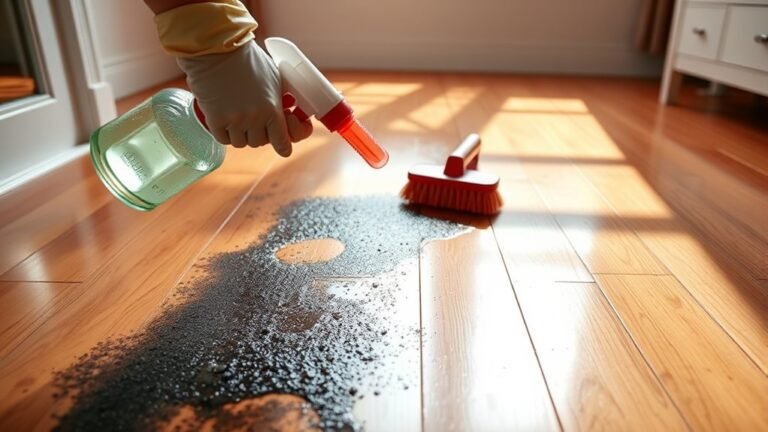How to Reduce Cleaning Costs in Tile
You can reduce tile cleaning costs by selecting durable materials like porcelain, which resist stains and require less maintenance. Use cost-effective, multi-purpose cleaners or DIY solutions such as vinegar and baking soda to avoid expensive products. Maintain a regular cleaning schedule with efficient tools like microfiber mops to optimize water and energy use. Applying sealants helps prevent dirt buildup, lowering cleaning frequency. These strategies streamline upkeep and cut expenses—explore further steps to maximize savings and efficiency.
Choose Cost-Effective Cleaning Products

Although premium cleaning products often promise superior results, you don’t have to spend a fortune to maintain tile effectively. Selecting cost-effective cleaning solutions involves prioritizing eco friendly options that combine efficiency with sustainability. These products reduce environmental impact while delivering strong cleaning performance, minimizing the need for frequent reapplication. Additionally, consider bulk purchasing to lower unit costs and guarantee a consistent supply. Buying in larger quantities reduces packaging waste and administrative expenses, translating into direct savings. Focus on multi-purpose cleaners compatible with tile surfaces to avoid unnecessary product specialization, which drives up costs. By strategically choosing eco friendly, bulk-purchased products, you maintain tile integrity and cleanliness without compromising your budget or freedom to allocate resources elsewhere. This approach maximizes value and supports long-term cost reduction.
Implement a Regular Cleaning Schedule
Since consistent maintenance prevents dirt buildup and damage, implementing a regular cleaning schedule is essential for controlling tile cleaning costs. You’ll want to establish an ideal cleaning frequency based on tile type and foot traffic. Schedule reminders help maintain this routine without guesswork, ensuring timely upkeep that extends tile lifespan.
| Tile Type | Cleaning Frequency | Schedule Reminders |
|---|---|---|
| Ceramic | Weekly | Set phone alerts |
| Natural Stone | Bi-weekly | Use calendar notifications |
| Porcelain | Twice weekly | Automated email reminders |
Use Microfiber Cloths and Mops

Anyone looking to cut tile cleaning costs should consider using microfiber cloths and mops. Microfiber benefits include superior dirt and dust capture due to their dense fiber structure, which requires less water and cleaning agents. This increases cleaning efficiency, allowing you to cover more surface area quickly without sacrificing quality. Microfiber materials are also durable, reducing replacement frequency and overall expenses. They effectively remove soil from grout lines and textured tiles where traditional methods struggle, enhancing thoroughness without extra labor. By integrating microfiber tools into your routine, you minimize chemical usage and water waste, aligning with a cost-effective, eco-friendly cleaning strategy. This approach offers you both freedom from heavy manual scrubbing and control over ongoing maintenance costs, making it a smart investment for tile care.
Prevent Dirt Buildup With Sealants
You can prevent dirt buildup by applying the right tile sealant, which creates a protective barrier against stains and grime. Selecting the appropriate sealant type and using proper application techniques are critical for effectiveness and longevity. Regular maintenance and timely reapplication guarantee the sealant continues to reduce cleaning frequency and costs.
Types of Tile Sealants
Although tile surfaces are inherently durable, applying the right sealant is crucial to prevent dirt buildup and reduce long-term cleaning costs. You’ll primarily encounter two types: penetrating sealants and topical sealants. Penetrating sealants absorb into the tile and grout, creating an invisible barrier that repels water and dirt without altering the tile’s natural appearance. This option is ideal if you prefer a matte or natural look. On the other hand, topical sealants form a protective layer on the surface, often producing glossy finishes that enhance aesthetics while providing dirt resistance. Choosing between these depends on your desired look and maintenance preferences. By selecting the appropriate sealant, you guarantee easier cleaning and extended tile lifespan, granting you freedom from frequent intensive maintenance.
Application Techniques
Selecting the right sealant is only part of effective tile maintenance; how you apply it directly impacts its performance and longevity. To prevent dirt buildup, use precise application methods like a clean, lint-free cloth or a high-quality brush to guarantee even coverage without excess pooling. Avoid rushing—allow the sealant to penetrate the tile and grout thoroughly before wiping away any residue. Implement cleaning techniques such as surface preparation; make sure tiles are completely dry and free from contaminants prior to sealing. This promotes ideal adhesion and maximizes dirt resistance. Proper application reduces the frequency and intensity of future cleaning, granting you more freedom from maintenance hassles while extending sealant effectiveness and protecting your tile investment over time.
Maintenance and Reapplication
Since sealants degrade over time due to foot traffic and cleaning agents, regular maintenance and timely reapplication are crucial to sustain their protective barrier. To implement effective tile longevity strategies, inspect sealant condition every six months, focusing on high-traffic areas. Clean the tile surface and grout thoroughly before reapplying sealant to guarantee peak adhesion. Utilize grout maintenance tips such as using pH-neutral cleaners and avoiding abrasive tools that can compromise the sealant. Reapply sealant following manufacturer guidelines—usually every 1-3 years—to prevent dirt buildup and staining. Consistent upkeep reduces cleaning frequency and costs by preserving the tile’s integrity. By integrating these maintenance practices, you safeguard your tile investment while enjoying greater freedom from intensive cleaning routines.
Utilize DIY Cleaning Solutions
When you want to cut cleaning expenses, utilizing DIY cleaning solutions offers an effective and budget-friendly approach. Start by preparing a vinegar solution—mix equal parts of white vinegar and water—to naturally disinfect and dissolve grime on tile surfaces. For tougher stains or grout buildup, apply baking soda directly, then spray the vinegar solution over it. The chemical reaction helps lift dirt without harsh chemicals, preserving tile integrity. After a short dwell time, scrub gently with a soft brush and rinse thoroughly with warm water. This method reduces reliance on costly commercial cleaners while maintaining tile hygiene. By mastering these DIY solutions, you gain control over cleaning frequency and product use, ultimately lowering costs and extending tile lifespan without sacrificing cleanliness or freedom from expensive supplies.
Train Staff or Household Members on Proper Cleaning Techniques

Although investing time in training staff or household members might seem demanding initially, it greatly reduces tile cleaning errors that lead to damage or increased maintenance costs. Proper staff training guarantees consistent application of effective cleaning techniques, preserving tile integrity and extending lifespan.
| Task | Recommended Cleaning Technique | Common Mistake |
|---|---|---|
| Daily Maintenance | Use pH-neutral cleaner | Harsh chemicals |
| Grout Cleaning | Soft brush, gentle detergent | Abrasive scrubbing |
| Stain Removal | Spot treat with baking soda | Excessive water usage |
| Sealing (if needed) | Apply sealant evenly | Skipping sealant |
Invest in Durable and Easy-to-Clean Tile Materials
You should select tile materials known for their durability to minimize replacement frequency. Prioritize surfaces that resist stains and require minimal upkeep to cut down cleaning time and costs. Investing upfront in low-maintenance tiles guarantees long-term savings and easier maintenance.
Choose Long-Lasting Tile Types
Since tile maintenance directly impacts your cleaning expenses, selecting materials that combine durability with ease of cleaning is essential. You should prioritize tile types known for their long lifespan and resistance to wear. Ceramic durability is a key factor; it withstands scratches and stains effectively, reducing replacement frequency. Porcelain benefits include higher density and lower porosity, which minimize moisture absorption and inhibit mold growth, cutting down cleaning needs. Additionally, these materials resist harsh chemicals, allowing you to use efficient cleaning agents without damage. By choosing long-lasting tiles like ceramic or porcelain, you limit costly repairs and labor-intensive upkeep. This strategic selection grants you freedom from frequent maintenance, ultimately lowering your overall cleaning costs while maintaining a pristine surface.
Opt for Low-Maintenance Surfaces
When aiming to reduce cleaning costs, opting for low-maintenance tile surfaces is essential because these materials require less effort and fewer specialized products to keep clean. You should prioritize tiles with glossy finishes, as their smooth surfaces resist dirt accumulation and simplify wipe-downs. Conversely, textured surfaces, while visually appealing, tend to trap grime, increasing cleaning time and costs. Durable materials such as porcelain or glazed ceramic combine longevity with ease of maintenance, minimizing the need for frequent deep cleans or replacements. By selecting tiles that balance aesthetics with practicality, you reduce dependence on harsh chemicals and labor-intensive methods. This approach not only cuts expenses but also grants you more freedom from ongoing maintenance hassles, allowing you to enjoy your space with minimal cleaning commitment.
Optimize Water and Energy Usage During Cleaning
Although cleaning tile surfaces thoroughly is vital, maximizing water and energy usage can greatly lower your overall costs. Use water at a moderate temperature; excessively hot water increases energy consumption without greatly improving cleaning effectiveness. Employ energy-efficient cleaning equipment designed to minimize electricity use while maintaining performance. Consider timing your cleaning cycles during off-peak energy hours to reduce utility expenses. Utilize methods like microfiber mops that require less water, cutting both water and energy demands for drying. Regularly maintain your cleaning devices to guarantee peak energy efficiency and prevent waste. By controlling water temperature and prioritizing energy-efficient tools and practices, you’ll reduce expenses and gain the freedom to allocate resources elsewhere—making your tile maintenance both cost-effective and environmentally responsible.
Häufig gestellte Fragen
How Often Should Professional Tile Deep Cleaning Be Scheduled?
You should schedule professional tile deep cleaning based on deep cleaning frequency guidelines from experts. Most professional recommendations suggest every 12 to 18 months, depending on tile usage and environment. If your space experiences heavy foot traffic or moisture, consider shorter intervals. Staying consistent with this schedule helps maintain tile integrity and appearance, giving you freedom from constant upkeep while ensuring long-term durability without excessive cleaning costs.
Can Certain Tile Patterns Hide Dirt Better Than Others?
Think of tile patterns as camouflage in nature—some designs subtly mask imperfections. When you choose pattern selection with minimal color contrast, dirt and stains blend more seamlessly, reducing visible grime. Complex, busy patterns with varied hues scatter attention, helping you maintain a cleaner look longer. By strategically selecting tiles with these attributes, you gain freedom from constant upkeep, ensuring your space stays visually fresh with less frequent, intensive cleaning.
What Are the Environmental Impacts of Tile Cleaning Chemicals?
You should know that traditional tile cleaning chemicals often contain harsh substances damaging to ecosystems and water supplies. Using chemical alternatives like vinegar or baking soda offers eco friendly solutions that minimize pollution and health risks. These green options break down naturally, preserving your freedom from toxic exposure while maintaining cleanliness. By choosing such methods, you reduce environmental impact and promote sustainable cleaning without sacrificing efficiency.
Is Steam Cleaning Safe for All Types of Tile?
Steam cleaning is generally safe for many tile types, like ceramic and porcelain, thanks to its high-temperature vapor that loosens dirt without harsh chemicals. However, you should avoid using steam on natural stone tiles, such as marble or travertine, since the heat and moisture can damage their surface and cause discoloration. Always check your tile manufacturer’s guidelines before steam cleaning to guarantee you don’t compromise the tile’s integrity or finish.
How Does Humidity Affect Tile Cleaning Frequency?
You’ll notice that higher humidity levels increase moisture retention on tile surfaces, accelerating dirt buildup and mold growth. This means you’ll need to adjust your cleaning frequency accordingly, often cleaning more frequently in humid environments. Employing specialized cleaning techniques, like using dehumidifiers or moisture-resistant sealants, helps manage these effects. By understanding how humidity impacts tile maintenance, you can optimize your cleaning routine, ensuring durability and preserving tile appearance efficiently.






